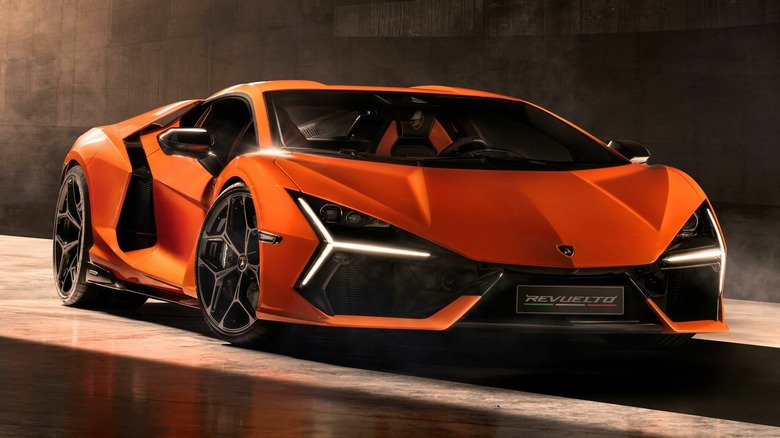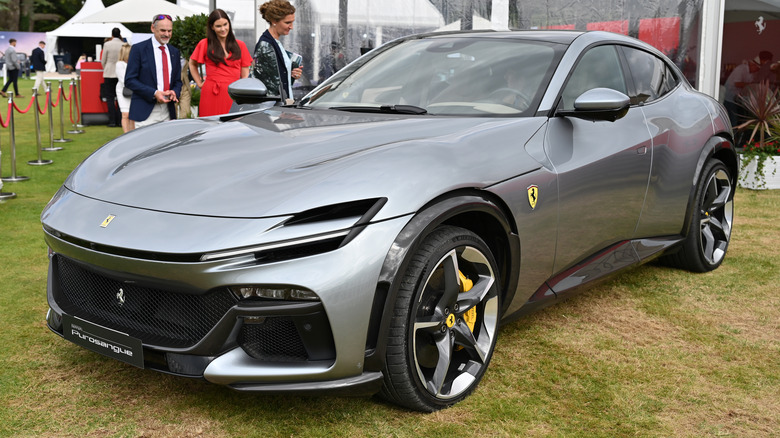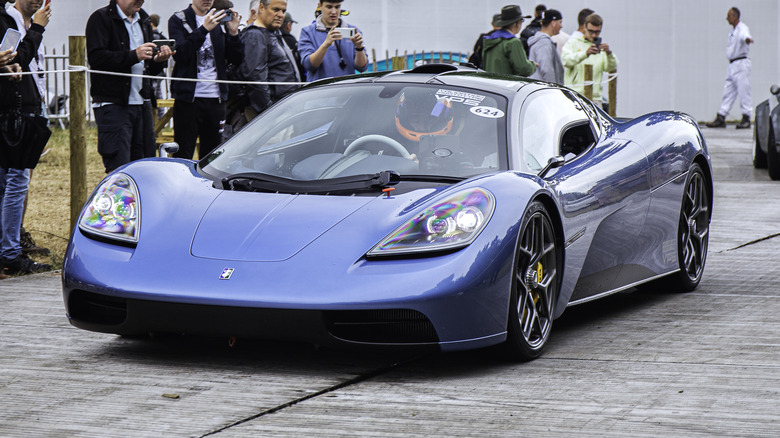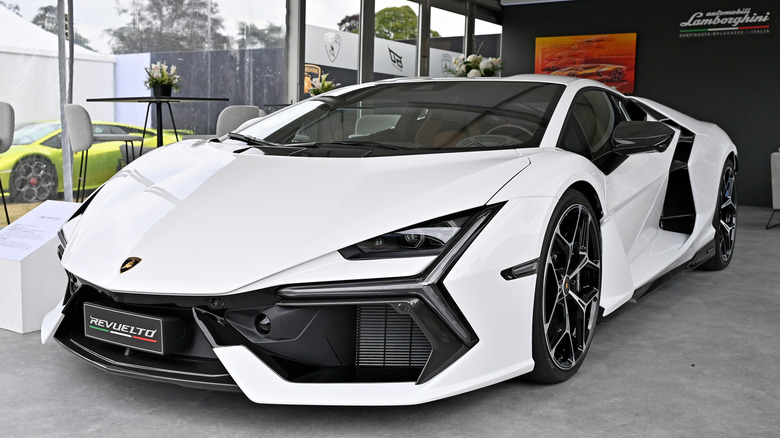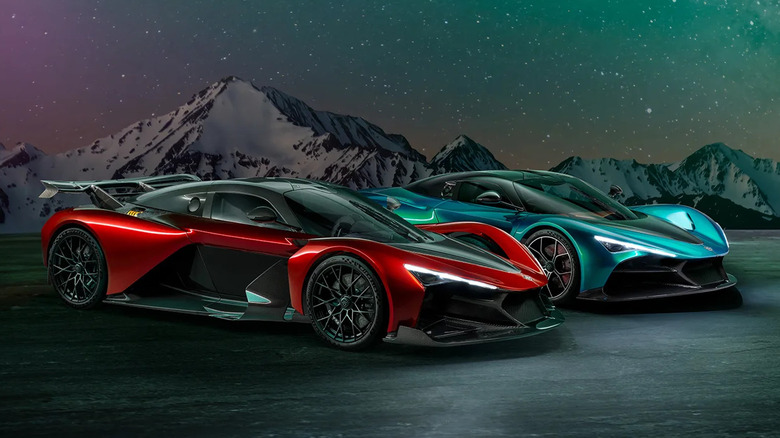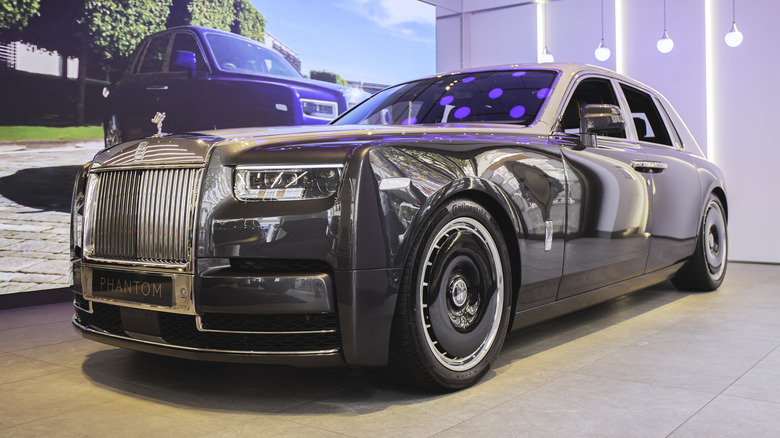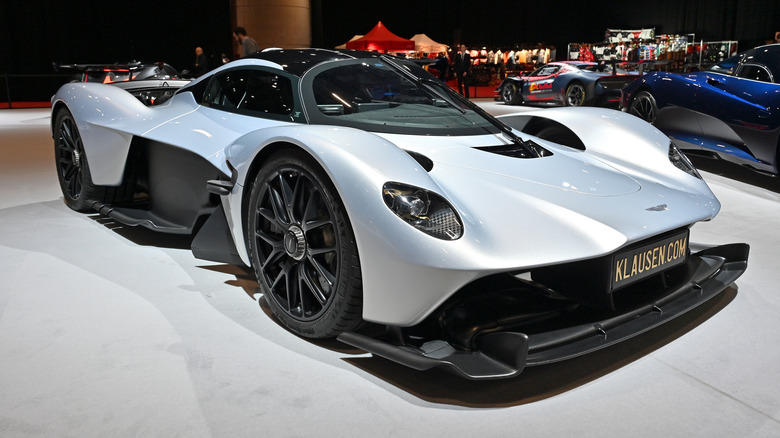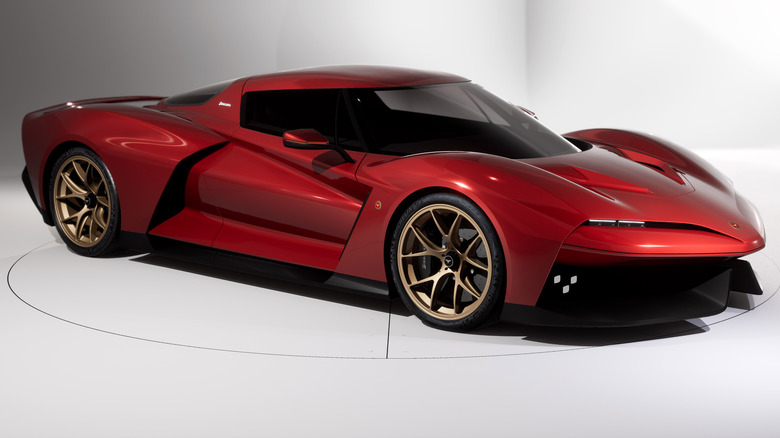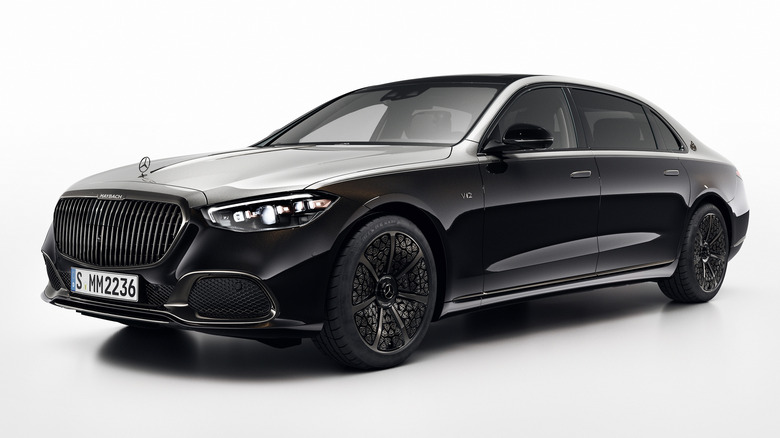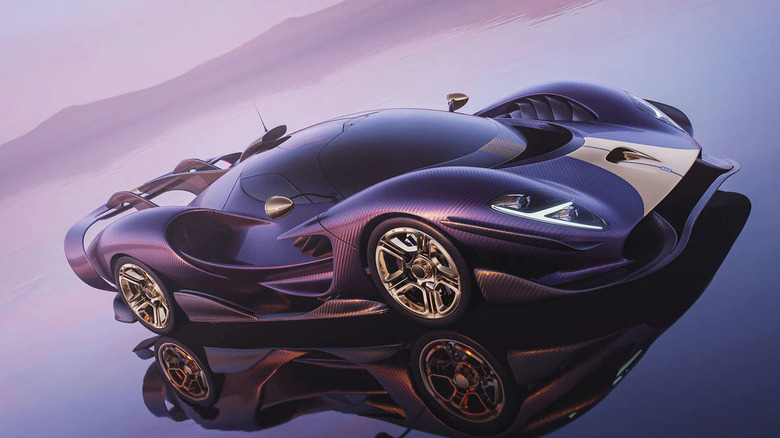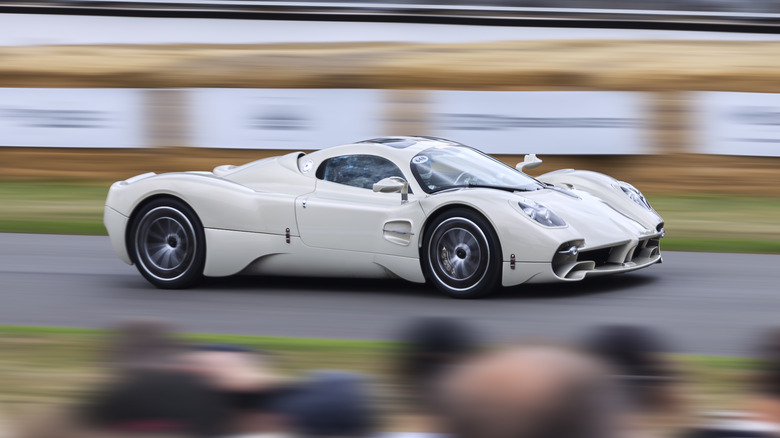10 Brands That Still Make Cars With V12 Engines
It's been common knowledge for years now: V12 engines are a dying breed. Tightening emissions regulations have made it increasingly difficult for manufacturers to continue producing the engine, with some choosing to phase them out altogether in favor of more efficient powertrains with fewer cylinders. However, to say the V12 is dead is categorically untrue — in fact, there's evidence that it's having a renaissance among boutique manufacturers looking to take advantage of its increasingly unique and exotic status.
Alongside those new players venturing into the world of making V12 cars, there are the legacy manufacturers for whom the V12 engine is an integral part of their history. Despite the incoming regulations, these brands and their loyal clients are more determined than ever to keep the V12 alive, developing innovative solutions to ensure cars with the revered engine keep rolling off the production line. We've rounded up a selection of automakers that fit into one of the two categories, all of whom have committed to producing cars with V12 engines through 2024 and beyond.
Ferrari
There is arguably no other brand whose history is as deeply entwined with that of the V12 engine than Ferrari. The brand's very first car, the 125 S, featured a 1.5L V12 engine and helped establish Enzo Ferrari as a name to watch in the motorsport world. More than three-quarters of a century after that first car was unveiled, the V12 continues to be an important element in Ferrari's enthusiast appeal today, even if V8-powered cars now make up the majority of the brand's lineup.
Ferrari launched the 812 GTS in 2019, with the car being the first unrestricted production Ferrari V12 roadster since the 365 GTS4 of 1969. It remains available for buyers in 2024, alongside another V12 car, the Purosangue SUV. With the seemingly unstoppable rise in SUV sales across all levels of the car industry, it seemed inevitable that even Ferrari would eventually cave into the trend. Despite bosses insisting as recently as 2016 that a Ferrari SUV would never happen, the Purosangue was unveiled in 2022 and quickly racked up such a long waiting list that the brand had to temporarily pause orders for the car.
Both the 812 GTS and the Purosangue use variants of the F140 V12 engine, which Ferrari has produced for more than two decades. It first debuted in the Enzo in 2002, and with record levels of interest surrounding its current V12 models, it seems the production of the engine will continue for the foreseeable future.
Gordon Murray Automotive
The designer of the McLaren F1, Gordon Murray, unveiled a new hypercar in 2020. Christened the GMA T.50, it was aimed at being the F1's spiritual successor, taking the original car's basic formula and incorporating the latest advancements in design and performance technology. One key element of the '90s design carried over was the naturally-aspirated V12 engine, although, unlike the McLaren, GMA's engine wasn't designed by BMW.
Instead, it was created in collaboration with Cosworth, with 654 horsepower available from its 3.9L of displacement. The engine was the lightest V12 ever fitted to a road car at the time of its unveiling as well as the most power dense. Its redline is also unmatched – at 12,100 rpm, no other road car comes close.
With such an exceptional engine at his disposal, it's no surprise that Murray also opted to use it for his next project, the T.33. Unveiled in 2022, the T.33 is more conventional than the T.50 — it doesn't feature fans or a central driving position — and it's a little less powerful too, although only just. The GMA-Cosworth V12 in the T.33 makes 607 horsepower and redlines at 11,100 rpm, less than the T.50 but still higher than almost any other road car on the market. These exceptional specs have been matched by exceptional customer demand, and all units of both cars are now sold out.
Lamborghini
The biggest hurdle V12-powered cars face is getting them to qualify for the increasingly strict emissions regulations being put in place in major markets around the world. Automakers have been trying out a variety of solutions to get around the problem, with Lamborghini taking the step of making its latest flagship supercar a hybrid for the first time. As part of that hybridization, the new Revuelto can travel up to 6.2 miles on all-electric power. This new setup allows the car to retain a mid-mounted 6.5L V12 engine and also significantly increases overall power output, with the Revuelto making a landmark 1,001 combined horsepower.
It's great to see that Lamborghini has confirmed its allegiance to the V12 for the foreseeable future, and what's even better is that the hybrid system actually improves the driving experience rather than hinders it. SlashGear tested the new Revuelto on track in Italy and found the extra hybrid boost while cornering to be a particularly big improvement over the outgoing Aventador. The battery can be charged externally, but the car also features a new regen system that doubles up as traction control by ramping up regen to prevent excess wheelspin. Many were impressed by the Revuelto's talents — customer demand is so high that the waitlist for the car is reportedly approaching three years long.
Zenvo
Danish hypercar maker Zenvo has been building cars for over 15 years, with all of its previous cars featuring a mid-mounted V8 engine. However, for its latest Aurora hypercar, the brand took the unusual step of developing its own all-new V12 engine in collaboration with Mahle Powertrain. The 6.6L quad-turbocharged engine produces 1,250 horsepower, making it the most powerful V12 ever fitted to a road car according to Zenvo. It's paired with a trio of electric motors developing 600 horsepower, for a combined output of 1,850 horsepower.
The engine has reportedly been called "Mjølner," being named after Thor's hammer in Norse mythology. It should make a fittingly thunderous soundtrack at full throttle, but the car will also be able to travel nearly silently for up to 21 miles on all-electric power. Zenvo claims the car's top speed sits somewhere in excess of 280 mph, and it can sprint from 0-62 mph in a mere 2.3 seconds. Assuming those figures are accurate, that makes it one of the fastest cars in the world, but it's priced accordingly. In fact, the Aurora is one of the most expensive hypercars ever built, with a $3.9 million price tag.
Rolls-Royce
The world's greatest luxury car brand might have dipped its toe into electrification with the launch of the Spectre BEV, but for now, at least, it remains committed to its long-running V12 engine for the flagship Phantom limousine. The 2024 Phantom features a twin-turbocharged V12 engine making 563 horsepower, although all-out performance never mattered much to Rolls-Royce buyers. Instead, they'll be much more bothered about the engine's unrivaled smoothness and its nearly silent operation.
Being able to neither hear nor feel the engine gives the Phantom's cabin a unique sense of serenity, shielding its VIP occupants from the bustle of the real world. It's this need for silent, smooth operation that makes Rolls-Royces an ideal candidate for electrification, and as the Spectre proves, the technology is already there to make it happen. But, as long as buyers continue to lap up the Phantom and V12-powered Cullinan SUV, it's unlikely that the brand's V12 engines will be going anywhere anytime soon.
Aston Martin
To say that the development of the Valkyrie hypercar was a huge project would be an understatement. With Adrian Newey at the helm, the development costs of the Valkyrie were so huge that it completely derailed Aston Martin's finances, leaving the company with a loss of over half a billion dollars in 2022. However, the resulting car arguably justifies the financial pain it has caused its maker. It's Aston Martin's most advanced production car to date, and at its heart sits an all-new Cosworth-built 1,000 horsepower 6.5L V12 engine.
An auxiliary electric motor brings the Valkyrie's total output up to a combined 1,140 horsepower, but that's almost beside the point — it's the V12 that steals the show. With a redline of 11,100 rpm, the engine is more akin to that of a Formula 1 car than a run-of-the-mill performance car. Its four-figure horsepower output is even more impressive when you consider that there are no turbochargers here for extra boost. Instead, the engine is naturally aspirated to evoke "the spine-tingling, ultra-high-revving F1 engines of the 1990s," according to Aston Martin.
Despite a multi-million dollar price tag, demand for the Valkyrie has reportedly been high and has helped to turn around Aston Martin's financial situation in recent months. However, the company has yet to make any long-term commitment to V12 development past its current projects, and its next roadgoing hypercar, the upcoming Valhalla, will feature a hybrid V8 powertrain.
Bizzarrini
The Bizzarrini brand can trace its origins back to the mid '60s, when legendary engineer Giotto Bizzarrini decided to launch his own car brand after falling out with one of Italy's most famous names. He had previously worked on landmark projects for Ferrari — most notably the 250 GTO — but left in 1961 after disagreements with Enzo Ferrari. He then spent some time working in a freelance capacity, designing the first Lamborghini V12 engine among other projects, before founding Bizzarrini SpA in 1964. Unfortunately, financial issues meant that the brand was short-lived, folding just five years after its launch.
Many decades later in 2020, a continuation of its most famous model, 5300 GT Corsa, saw the Bizzarrini marque brought back to life. In 2023, the resurrected brand announced its first all-new hypercar, named after its founder. The Giotto features styling by Giorgetto Giugiaro and is powered by a 6.6L V12 engine, developed in conjunction with Cosworth. It's a clean-sheet design that isn't related to Cosworth's other V12 projects with Aston Martin or GMA, although precise details are limited for now. Cosworth says it plans to get prototype engines running on its dynos by "late Q2 2024." At present, all that's confirmed is that the engine's displacement will reference Giotto Bizzarrini's birthday — it has a capacity of 6626cc (6.6L), with Bizzarrini born on the 6th of June 1926.
Mercedes-Maybach
While Mercedes-Benz S-Class limousines are no longer available with V12 engines, their pricier Maybach counterparts can still be bought with one for now. The 2024 Mercedes-Maybach S680 4Matic starts at roughly $235,000 and features a 6.0L variant of the German automaker's long-running V12 engine. Much like Rolls-Royce's V12 engine, the Maybach engine is designed to be smooth above all else. Power figures aren't really important, although they're impressive here nonetheless — the Maybach packs 621 horsepower distributed to all four wheels through the 4Matic all-wheel drive system.
Every other element of the Maybach S680 is exactly as buyers will expect: it's ultra-luxurious, assembled with painstaking attention to detail, and highly customizable. The Maybach is roughly double the price of a standard Mercedes-Benz S Class, but for those buyers who simply must have a V12, it's a price they'll have to pay. For how much longer the V12 will remain available, however, is hard to say. There were reports that Mercedes was looking to phase them out as far back as 2008, but for now, they continue to be offered at the very top of its lineup.
De Tomaso
Another resurrected Italian brand in the same vein as Bizzarrini, De Tomaso is back making ultra-exclusive hypercars under new Chinese ownership. The latest of those is the P900, the track-only follow-up to the P72. It boasts a bespoke V12 engine built by German engineering firm Capricorn, claimed to be the lightest and shortest V12 ever fitted to a production car. This engine, it should be noted, is not the V12 from the prototype P72, instead being an unrelated design.
Its spec sheet is impressive, to say the least: a claimed 12,300 rpm redline, a 900 horsepower output, and design inspiration from LMP1 prototype racers. The P900, and indeed its engine, is still earlier in development than most of the other cars here. So, it's worth taking the car's performance claims as just that — no more than claims — for now.
The P900 isn't the first time that De Tomaso has promised V12 power for one of its cars, although, no customer cars have featured such an engine. The P72 prototype initially debuted with a V12, but production cars featured a V8. There's no indication for now that the P900 will follow the same path, however.
Pagani
One of Italy's most instantly recognizable carmakers, Pagani has always remained committed to its AMG-sourced V12 engine. Its latest product, the Utopia, carries on the tradition, with Pagani stating that its aim was to go "against the main trends of the time." That means there are no hybrid systems or dual-clutch transmissions, with the brand instead offering a 6.0L twin-turbo V12 making 864 horsepower. Buyers get the choice of either a seven-speed manual or a seven-speed automatic transmission. The engine is still built to order by Mercedes-AMG, even though AMG no longer offers such a V12 in its cars.
The Utopia, developed under the codename "C10," is just as exclusive as previous Pagani cars. In coupe form, it's limited to 99 units, although there has so far been no confirmation of whether a roadster version will be revealed later. If one is indeed launched, expect it to be just as exclusive, and feature the same thundering V12 under its exotic bodywork.
